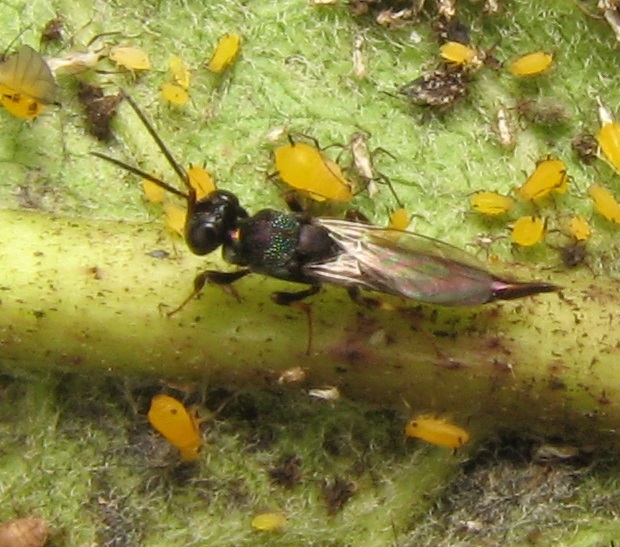|
Eupelmidae
Eupelmidae is a family of parasitic wasps in the superfamily Chalcidoidea. The group is apparently polyphyletic, though the different subfamilies may each be monophyletic, and may be elevated to family status in the near future. As presently defined, there are over 905 described species in 45 genera. The larvae of the majority are primary parasitoids, commonly on beetle larvae, though many other hosts are attacked, including spiders, and details of the life history can be variable (e.g., some attack eggs and others are hyperparasites). They are found throughout the world in virtually all habitats. They are somewhat variable in appearance, though a fair number of species are relatively easy to separate from other Chalcidoidea by the possession of a medially concave mesonotum. They also have the unusual tendency to arch the body strongly upwards when dead, with the head and metasoma often nearly touching above the thorax. Genera *'' Anastatus'' *'' Arachnophaga'' *'' Archaeopelm ... [...More Info...] [...Related Items...] OR: [Wikipedia] [Google] [Baidu] |
Chalcidoidea
Chalcid wasps (, , for their metallic colour) are insects within the superfamily Chalcidoidea, part of the order Hymenoptera. The superfamily contains some 22,500 known species, and an estimated total diversity of more than 500,000 species, meaning the vast majority have yet to be discovered and described. The name "chalcid" is often confused with the name "chalcidid", though the latter refers strictly to one constituent family, the Chalcididae, rather than the superfamily as a whole; accordingly, most recent publications (e.g.,) use the name "chalcidoid" when referring to members of the superfamily. Most chalcid wasps are parasitoids of other insects, though other life styles are known, with the herbivorous fig wasps acting as pollinators. Various species are used as biological pest control agents or in scientific research. Description Chalcidoids are generally small wasps, averaging 1.5 mm in length and usually being less than 3 mm. The body is often metallic in colour. T ... [...More Info...] [...Related Items...] OR: [Wikipedia] [Google] [Baidu] |
Anastatus
''Anastatus'' is a large genus of parasitic wasps belonging to the family Eupelmidae. The genus has cosmopolitan distribution. Species *'' Anastatus absonus'' *'' Anastatus acherontiae'' *'' Anastatus adamsi'' *'' Anastatus aereicorpus'' Girault, 1925 *'' Anastatus alaredactus'' Narendran, 2009 *'' Anastatus bifasciatus'' (Geoffroy, 1785) *'' Anastatus biproruli'' (Girault, 1925) *''Anastatus disparis'' *'' Anastatus dexingtensis'' Sheng & Wang, 1997 *'' Anastatus echidna'' (Motschulsky, 1863) *'' Anastus flavipes'' Sheng & Wang, 1997 *'' Anastatus fulloi'' Sheng & Wang, 1997 *'' Anastatus mantoidae'' Motschulsky Victor Ivanovich Motschulsky (sometimes Victor von Motschulsky, russian: link=no, Виктор Иванович Мочульский, 11 April 1810, in St. Petersburg – 5 June 1871, in Simferopol) was a Russian entomologist mainly interested in ..., 1859 *'' Anastatus huangi'' Sheng & Yu, 1998 *'' Anastatus orientalis'' Yang and Choi, 2015 References {{Taxo ... [...More Info...] [...Related Items...] OR: [Wikipedia] [Google] [Baidu] |
Brasema
''Brasema'' is a genus in the family Eupelmidae. Species *'' Brasema acaudus'' *'' Brasema allynii'' *''Brasema antiphonis'' *'' Brasema aprilis'' *''Brasema aurata'' *'' Brasema baccharidis'' *'' Brasema bardus'' *'' Brasema basicuprea'' *''Brasema brevicauda'' *'' Brasema brevispina'' *'' Brasema bruchivorus'' *'' Brasema cerambycoboidea'' *''Brasema chapadae'' *'' Brasema cleri'' *'' Brasema coccidis'' *''Brasema corumbae'' *''Brasema dryophantae'' *''Brasema flavovariegata'' *''Brasema fonteia'' *''Brasema hetricki'' *''Brasema homeri'' *''Brasema incredibilis'' *''Brasema inyoensis'' *''Brasema juglandis'' *''Brasema kim'' *''Brasema lacinia'' *''Brasema lamachus'' *'' Brasema lambi'' *''Brasema leucothysana'' *'' Brasema limneriae'' *''Brasema longicauda'' *'' Brasema macrocarpae'' *'' Brasema maculicornis'' *'' Brasema maculipennis'' *'' Brasema mandrakae'' *''Brasema mawsoni'' *''Brasema neococcidis'' *'' Brasema neomexicana'' *'' Brasema nigripurpurea'' *'' Brasema peruv ... [...More Info...] [...Related Items...] OR: [Wikipedia] [Google] [Baidu] |
Balcha (wasp)
''Balcha'' is a genus of chalcid wasps in the family Eupelmidae. There are about 16 described species in ''Balcha''. Species These 16 species belong to the genus ''Balcha'': * '' Balcha anemeta'' (Walker, 1846) * '' Balcha camptogastra'' Gibson, 2005 * '' Balcha cylindrica'' Walker, 1862 * '' Balcha dictyota'' Gibson, 2005 * '' Balcha elegans'' (Masi, 1927) * '' Balcha enoptra'' Gibson, 2005 * '' Balcha eximia'' (Masi, 1927) * '' Balcha eximiassita'' Gibson, 2005 * '' Balcha indica'' (Mani & Kaul, 1973) * '' Balcha laciniosa'' Gibson, 2005 * '' Balcha levicollis'' (Cameron, 1908) * '' Balcha punctiscutum'' Gibson, 2005 * '' Balcha reburra'' Gibson, 2005 * '' Balcha reticulata'' (Nikol'skaya, 1952) * '' Balcha reticulifrons'' Gibson, 2005 * '' Balcha splendida'' (Girault, 1927) c g Data sources: i = ITIS, c = Catalogue of Life, g = GBIF, b = Bugguide.net References Eupelmidae {{chalcidoidea-stub ... [...More Info...] [...Related Items...] OR: [Wikipedia] [Google] [Baidu] |
Francis Walker (entomologist)
Francis Walker (31 July 1809 – 5 October 1874) was an English entomologist. He was born in Southgate, London, on 31 July 1809 and died at Wanstead, England on 5 October 1874. He was one of the most prolific authors in entomology, and stirred controversy during his later life as his publications resulted in a huge number of junior synonyms. However, his assiduous work on the collections of the British Museum had great significance. Between June 1848 and late 1873 Walker was contracted by John Edward Gray Director of the British Museum to catalogue their insects (except Coleoptera) that is Orthoptera, Neuroptera, Hemiptera, Diptera, Lepidoptera and Hymenoptera. Walker largely accomplished this and (Edwards, 1870) wrote of the plan and by implication those who implemented it “It is to him raythat the Public owe the admirable helps to the study of natural history which have been afforded by the series of inventories, guides, and nomenclatures, the publication of which beg ... [...More Info...] [...Related Items...] OR: [Wikipedia] [Google] [Baidu] |


